I Like Charade in June/ How About You?
As is inevitable in this day and age, one occasionally gets involved in a “What was your lockdown like?” conversation. I just avoided going to a college reunion, and I’m sure much of the smallest of talk would have centered around trading anecdotes about isolation from family and support structures, about juggling parenting, schooling, and work-from-home, of eldest children trying to figure out how much college was actually worth when another Covid variant could cause another stretch of remote learning from within the college’s dorms. The personal cost of the pandemic has been and will continue to be wildly varied, which makes it both an interesting conversation starter and an easy way to reveal vast gulfs of experience on either side of an anecdote.
My final pre-shutdown experience back in March of 2020 was deciding that it probably was not the better part of valor to venture out to a Welcome to Night Vale performance when I knew the governor was about to declare a state of emergency as soon as the timing was right for a press conference. But a scant two weeks before that, I’d closed out a weekend of entertainment by walking around the Museum of Modern Art with an old roommate talking about the growing fears of infection and how seriously we should take the burgeoning news coverage. Prior to that, the weekend had consisted of my first ever attendance at an actual Broadway show and the achievement of a long-awaited dream of visiting the New York Public Library’s Charade collection.
That’s not what it’s officially called, of course. But, as I’ve previously mentioned, the Library of Performing Arts’ collection of the papers of Charade screenwriter Peter Stone were an enticement that had been hovering over my NYC visits for some time. I’d previously had an opportunity to swing by and plunge into the archives, Scrooge McDuck-stylee, in November of 2017 when I unexpectedly found myself with five hours to kill between planned events. But I was with company and asking them to wait while I poured over ephemera of little interest to anyone else felt like the height of rudeness (he says on a blog where he’s detailing some of that ephemera). So I put it off until I found myself with another window of time to kill between events and was flying solo. Some people find it lonely and a little scary to travel by one’s self, but I find if one is looking to spend a literal half-day taking notes on contract details and script annotations of a minor ’60s romantic thriller comedy, it’s best not to trespass on another person’s patience. My friends were politely bored enough having to listen to me gush about the experience afterward; to deal with with it in real-time would surely have been unreasonable.
What is reasonable, unfortunately, are the fairly stringent copyright protections instituted by NYPL about the fabulous things that I found there. Obviously, they are aware that they have many, many things in their collection that are not in the public domain, and despite the fact that anyone with a digital camera and a library card could cheerfully make the protected contents of their archives significantly less protected, their policy states that “The Library does not grant written permission for any type of use of reproductions taken by readers“, and that photographs are only for “personal use”. I have read and re-read the permissions policy, and while I would say that the narcissistic ouroboros of non-commercial blogging is much more adjacent to personal use than it is to publication, I understand that this perspective probably wouldn’t stand up against a cease-and-desist notice. Since copyright is designed to prevent unlicensed reproductions that will stifle, divert, and lessen sales, excerpts or “transformative works” that aren’t going to reduce access to and sales of the original aren’t considered violations. Which is why this post won’t be a catalogue of all the minutiae I’ve teased above. I have instead clipped a portion of an image from the NYPL’s “Peter Stone” image collection of a man in a smart… waistcoat, but changed it enough to hopefully make it something sufficiently Other. I’m pretty sure that is permissible — and desirable, as something to slightly break up this unremitting block of self-indulgent twaddle with an image — but I’ve been wrong about the legality of Charade-based copyright issues before.
Read the rest of this entry »Unsinkable! She Alive, Dammit! (It’s a Miracle!)
As of yesterday, it’s been 25 years since the countrywide opening of James Cameron’s Titanic, and it’s been seven months and three days since I finally watched it for the first time. We all have films that we’ve foresworn against, not because of having actually watched them, but because of the way they were sold to us. I remember my stepbrother going from hot to cold on Batman in 1989 as the hype amassed. As more and more people told him how great it had to be based on the budgets and the promotional photos and merchandizing, the more his fundamental contrarianism marshaled arguments based on similar — if not the same! — snapshotted details. As a young person who’d been swept away the achievements of Terminator 2: Judgement Day, who’d been wowed by the relentless pulp of True Lies, and who — having read and re-read Orson Scott Card’s expansion of The Abyss — hoped that one day the eventual video release of the extended director’s cut of Cameron’s full-budget vision would salvage the deus ex profunda ending, I should have been in the proverbial fifteen million-gallon tank for Cameron’s disaster romance. But I wasn’t. I found the whole existence of the exercise crass, and all the details that emerged about the manic attention to accuracy and the whirlwind glamour of the central story served only to bolster my recalcitrant position. I was the Titanic “truther” of 1997.
And why was this? At its heart, it was because in elementary school I’d read and re-read the Walter Lord’s step-by-step retelling of the sinking, A Night to Remember (a title I always think of when high school proms inevitably use that as the motto for their coming-of-age event). That slim volume — which only breaks two hundred pages by including the passenger list at the end — captured my imagination in a way that few other non-fiction books did. Despite being, notionally, a boy, I don’t have any memory of going through the traditional concrete operational period of falling in love with mechanics and statistics. While many, manymany boys process a desire for and attraction to functional and measurable aspects of reality, becoming obsessed with fire trucks or train sets, or starting to memorize baseball statistics, the closest I got to this sort of world was loving Lego and instinctively memorizing all the members of the X-Men. But, for me, that was about storytelling and characters, and the Dorling-Kindersley approach to the world — pictorial categorization of concrete phenomena — wasn’t interesting unless there was something especially aesthetic or connected to media where I’d become invested in the ‘verse.
So A Night to Remember was an interesting combination of those two worlds — a minute-by-minute accounting of events, decisions, and individuals involved in the collision, evacuation, and sinking, but told in a way that I could envision it as a narrative — but also with enough tension between the two techniques that I returned to it again and again… potentially looking for color, personality, and something beyond the blank, absurdist tragedy of the event to hang my hat on. And, weirdly, I did read and re-read — sometimes dutifully, sometimes skimming — that list of names, looking for something or someone to connect to that would make it real in a personal sense instead of in the larger, abstract sense of Having Actually Happened.
From that perspective, Titanic, as James Cameron executed it, should have been exactly what I wanted: the ability to distill it down to an emotional adventure story so that it existed both on the micro and macro scopes, historical and personal, massive and individual. But it didn’t strike me that way. Somewhere between ages ten and twenty-one, I’d embraced an adolescent ’90s nihilism that made me content with the stark, appalling meaninglessness of the true events. I suspect that this happened after the National Geographic footage of the rediscovery of the ship in its resting place, majestic in size, but otherwise smeared by decades of the uncaring sludge of Nature. Much like having hubristically declared the ship as “unsinkable”, any glory or status it might have had was now diminished beneath the weight of organic inevitability, making Titanic look like a the flagship in a cruise line designed by Antoni Gaudi.
So the decision to make a spectacle of the glory of the boat, of recreating it as exactly as possible, and lavishing Titanic‘s extraordinary budget on facsimiles to be deliberately destroyed felt weirdly tone-deaf to me. If there was anything the underwater cameras showed us, it was that glitz and glory will crumble to the inevitability of rot and ruin. So to spend so, so much money to recreate the folly, and to spend so, so much money recording its deliberate destruction felt asininely wasteful. And to do it in service of a romance between two fictional people, created deliberately to represent the simplistic Harlequin Romance transgression of attraction across classes (!!!) felt disrespectful to the people who’d actually suffered and died, and whose names I’d read over and over.
Read the rest of this entry »Gather in the Drawing Room
My current practice of saving certain articles until I have time to concentrate on them has meant that I found out about the Fake Teenagers Festivus Blogathon a couple days late. Looking at my collection of oft-revisited physical media, I’m not sure what I would have immediately leapt to cover — perhaps Edward Scissorhands, which featured a 20 year-old Winona Ryder and a 22 year-old Anthony Michael Hall — but my secret goal of becoming relevant as a figure on Film Twitter will certainly be harder to achieve if I’m not pursuing clout and chasing trends before Twitter inevitably wheezes its final death rattle. Which means I will need to read movie commentary and articles, not at some distant leisure and certainly not after waiting a week for new cinema releases to lose lustre so I can see the film with a minimal audience on a Tuesday night. No, I might need to cultivate the anxious, wide-eyed panic of someone consumed with worry about no longer being streets ahead.
The recent film I did get a bit of a jump on was Glass Onion, which ended its limited theatrical release yesterday night before pausing to return as a cozy staple on Netflix in a month’s time. It was important to me to see Glass Onion in cinemas, as I have seen all of Rian Johnson’s film output in theatrical release so far, and I didn’t want to break the streak.
I believe I heard about Brick back when I was haunting the corridors of the TwitchFilm website (which I probably discovered chasing breadcrumbs about the theatrical release of Serenity, for my sins). I drove from grad school in Western Mass to the Coolidge in Boston to see a screening of Brick, and while I was disappointed with the fidelity of the digital projection, I was at least glad to have seen it in as large format as possible. The essential flashy conceits — the noir trappings, the arcane Young Person Code, and the curious mechanism where the plot of the film is being acted out by the high school theatre company while it’s still happening to the protagonists — were all attractive and clever, but I really responded to its essential technical filmmaking: the photography and the sound mix. I found myself won over by the choices of putting the strong, distinctive images together with the borderline absurdist touches that occurred throughout the script and production (Lukas Haas’ character’s accumulated quirks — the floor lamp in the back of his van, his mom’s chicken-shaped juice jug, and his attempt at making a human connection with JGL over the Tolkien books — all had me convulsing with laughter). It felt like a visual voice I wanted to continue to know, and it got me to follow Johnson’s career ever since.
Read the rest of this entry »IMDBLR: Son of IMDBLR
November 2015 was my fifth anniversary of my first joining and participating in the Kickstarter community. Slightly less than a year later, I backed my one hundredth project. In that time, I’d spent approximately $1,200 each year on autographs and comic books and albums and wedding presents and lithographs and fundraisers and film productions. I’d read articles decrying the fact that Kickstarter took advantage of funders because it wasn’t an investment system. If I’d been a producer on those films and albums and comics, and they’d proved to be successful, then I would have enjoyed a return on my investment. Instead, I would receive a shipment of tat, critics scoffed, and someone else would reap the real benefits.
I’m sure that somewhere in those 17 projects each year that I backed, one or two of them would be considered “successful”, but for me, the main draw of Kickstarter has always been the projected sense of “participation” in a given creative project. The updates from the creators are key to this: a regular series of follow-up messages about the progress and process of the actual project do make me feel like I’m involved, even if all I did was be part of the crowd of funders. It’s the — perhaps illusory — feeling of participation and pride that is the best part. And so the ability to point at one’s name and say, “I made this happen!” has become the real reason I continued with Kickstarter so avidly for so long.
Shortly after the end of the projects listed here, I backed off of Kickstarter. Not because of the money — although that clearly should have been a consideration, now that I crunch the numbers — but because I did come to the understanding that my internal sense of my “involvement” in these things was overinflated, and that they were part of a larger project of retail therapy I’d been participating in for some years. I enjoyed the vicarious thrill of the projects and the stories I was able to absorb from the production updates, but what I was really doing to a large degree was spending money to have exciting mail show up at some unexpected future date — and with Kickstarter projects, that date was almost always in significant flux… I needed less stuff in my life, and I needed less momentary novelty and excitement provided via the acquisition of said stuff.
There are still eleven outstanding film projects that I have backed — only four additional since I hit a hundred backed projects four years ago — and only three of which I believe will list my name in any manner (not including the Kurt Vonnegut documentary that already has me listed on their website). While I’m no longer actively chasing this kind of validation, I might as well keep cataloguing the last five projects that do name me and the last five that didn’t…
STANDING IN THE STARS: THE PETER MAYHEW STORY (Raised its minimum funds on Sept. 14, 2013, still unreleased)
THE FELT-LINED COUNTDOWN: The Muppet Movie
PREVIOUSLY: It’s all been building to this: the beginning of it all, if you don’t count, y’know, the TV show and the talk show appearances and the general omnipresence. This was huge. And it was. Box Office Mojo doesn’t have the opening weekend numbers for The Muppet Movie, but it does list the overall gross at $65.2 million in 1979 money, which adjusts to $234 million today, kicking the revival success of The Muppets at a comparatively mere $101.8 million into a cocked hat. It was wildly successful financially, and continues to be a massive emotional touchstone for fans and families.
And what’s weird is that it doesn’t even start with the banjo. It feels like it should. The DVD does. The Blu-ray does. The Blu-Ray’s “Intermission” feature does. It’s hard to imagine that this iconic picking wasn’t something that pre-grabs an audience and transports them back to memories of this film, but was once an eight-bar intro to an unknown quantity. And its even weirder that the film takes forever to get there, with a truly extended bookend sequence, that’s incredibly slowly paced and does little that’s iconic, with two exceptions: Kermit’s dialogue to Robin (“It’s sort of approximately how it happened…” and the fact that the theatre screening seats that were designed to hide Muppeteers beneath them have now become the standard for cinemas.
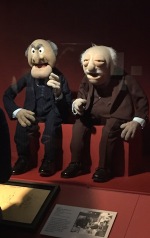 However, it would be remiss of me not to point out that The Muppet Movie does open with an absolute goddamn public service: it not only names Staler and Waldorf — names I can’t remember not knowing, but which seem to be largely opaque to much of the general public… a comprehensive text search of transcripts of current podcasts as well as conversations around me at the Museum of the Moving Image’s Jim Henson exhibit would reveal that hardly anyone knows that “those two old Muppets in the balcony” even have names — but also tells us which is which, something even I have trouble remembering on occasion. The film then very leisurely introduces the various personnages with a series of small in-character moments. The whole thing is very unhurried, maybe even deleteriously so. So it’s a welcome gag that Animal and the various Muppets (while displaying the worst cinema-going etiquette ever… something that they apparently were wont to continue thirty-two years later) get impatient for the film to begin and bully Kermit into starting the film without thanking everyone involved. (A joke, of course, continued in Muppet Caper‘s credits, as well — as I’ve previously mentioned — as in Bloom County in 1982.)
However, it would be remiss of me not to point out that The Muppet Movie does open with an absolute goddamn public service: it not only names Staler and Waldorf — names I can’t remember not knowing, but which seem to be largely opaque to much of the general public… a comprehensive text search of transcripts of current podcasts as well as conversations around me at the Museum of the Moving Image’s Jim Henson exhibit would reveal that hardly anyone knows that “those two old Muppets in the balcony” even have names — but also tells us which is which, something even I have trouble remembering on occasion. The film then very leisurely introduces the various personnages with a series of small in-character moments. The whole thing is very unhurried, maybe even deleteriously so. So it’s a welcome gag that Animal and the various Muppets (while displaying the worst cinema-going etiquette ever… something that they apparently were wont to continue thirty-two years later) get impatient for the film to begin and bully Kermit into starting the film without thanking everyone involved. (A joke, of course, continued in Muppet Caper‘s credits, as well — as I’ve previously mentioned — as in Bloom County in 1982.)
So it’s a full four and a half minutes before the banjo strings do their thing and our heartstrings do ours. Read the rest of this entry »
THE FELT-LINED COUNTDOWN: The Great Muppet Caper
PREVIOUSLY: As Fran Kubelik tells us, “Some people take, some get took — and they know they’re getting took — and there’s nothing they can do about it.” Well, Manhattan done got taken, that fool of a Took.
While Manhattan is my brother’s favorite Muppet film, and while I think some of his comments and perspective helped me appreciate it as a sketch-movie, my comments about its utter lack of an earned ending do stand. And after finishing watching and reading about Muppets Take Manhattan, I was looking forward to revisiting my personal favorite of the Muppet franchise, and seeing how well it holds up and how well it might weather the scrutiny I’d been applying to the other Muppet offerings.
The disappointing news is: not well. I’ve been doing a whole bit over the course of this series where I’ve found a Group of Three, highlighting it early in the write-up, and eventually using it as the way of rating the film as a Success, a Mixed Bag, or a Basic Failure. The obvious way to do that with Caper is with Fozzie, Kermit, and Gonzo’s shipping containers. My notes say that my alternate take for ratings of this movie were going to be “A) Credit Card, B) Cash, or C) Sneak Out In The Middle Of The Night.”
Which would mean, if this film was only middling in its success, I’d have to give it a RATING between Bears, Frogs, and Gonzos of Frogs, which seems mildly insulting to Kermit. Surely a rating of Frogs should be excellent! Something that’s a mixed bag should be a rating of what is says on Gonzo’s crate, which is Whatever, but that’s the lowest rating, which this film doesn’t deserve. Or, at least, my twenty-year upholding of this film as the pinnacle of Muppet filmmaking won’t let me allow it.
Because, unfortunately, what I love about this film is the strange tone and pacing and the excellent post-modern wall-breaking, and almost all of that goes out the window in the final act, leaving us with a badly-paced, badly-assembled mess that needs more than charm to let the audience feel like their earlier generosity was justified. The deconstruction and chaos need to either pay off in a manner that shows that the clash of fiction and metafiction was purposeful, or need to build to a complete explosion of structure that just abandons structure altogether.
But, in order to show how it goes wrong, we do have to start at the start. Which is pretty wonderful.
THE FELT-LINED COUNTDOWN: The Muppets Take Manhattan
PREVIOUSLY: The Muppets Take Victorian London. Those Muppets. It’s always take, take, take…
The film opens with a helicopter shot of New York City, and if you couldn’t already recognize parts of the skyline as dated, then the lack of a gyroscopic stabilizer on the camera would thorough date this footage as from the ’70s or ’80s. Immediately, the music starts with a loose series of dooting by Kermit, kind of scat singing — harkening forward to Whitmire’s excellent caroling with Tiny Robin in 1992 — but not really deviating from the melody as much as I associate with true jazz scat. Regardless, it is a pleasant introduction to the melody of “Together Again”, the song so catchy that they used it again as the closing number to Most Wanted thirty years later.
During this charming ditty, the name of the composer to the song comes up, and I have no idea who this is. “Music and Lyrics by Jeff Moss”? Who is this workaday imposter, I pre-emptively bristle. Well, allow Wikipedia to allay my immediate suspicions, as it turns out that Mr. Moss is the writer of “Rubber Duckie” and “I Love Trash”. This explains the catchiness of both the opening number and the later appearance of “I’m Gonna Always Love You”. I probably should have been able to let the music speak for itself, but it does help to know that the compositions come from the Muppet stable, as it were. It gives some faith in the proceedings to come.
That faith, unfortunately, is largely squandered in my eyes. The film has a perfectly fine notional story, with the Muppets taking their senior college revue to New York to try and get it produced on Broadway. Perfectly ordinary Rise To Fame narrative that would be pleasant… if it wasn’t basically the plot of The Muppet Movie from five years before. But that!, I hear the movie implore, was a film about a ragtag group of strangers coming together and finding each other; their success is based on the fact that they were stronger with each other! So the stakes of this movie will be that initial failure forces them to separate, and we are anxious about getting them reunited. All of this is encapsulated by the opening, which is the finalé of Kermit’s revue! So the film starts with its eventual conclusion, and it will all be full circle!
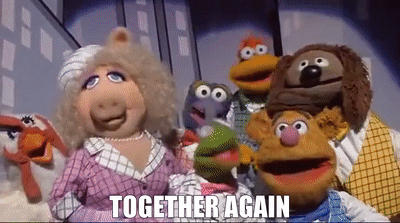
Which is a pretty great pitch. Which the film, I say again, squanders in many ways. I realize that I’m jumping straight to the end of the film, but the ending is very much what makes me stamp out of the cinema — or, now, my living room — irritated at the logical inconsistencies in the construction of this film. A film is not its ending, but the ending is the last thing a film leaves you with, and it can absolutely sour the previous hour and a half. The fact that the film doesn’t end with “Together Again” is nuts. Everything about the musical that they stage is nuts. It defies belief, it leaves me frustrated and irritated, and it makes me want to buy Muppets Take Manhattan Burger King glasses on eBay just so that I can smash them.
So let’s establish how the film violates our faith. Read the rest of this entry »
THE FELT-LINED COUNTDOWN: The Muppet Christmas Carol
PREVIOUSLY: A “Muppet” movie is made where the primary character dynamic is between Tim Curry and young actor Kevin Bishop. Because it’s a Muppet movie. With Muppets.
In the opening commentary for Muppet Treasure Island, director Brian Henson talked about the complexity of the opening pan, and the way it transitioned into the studio set, but that he’d opened Muppet Christmas Carol the same way. I gave him a little stick for the mild — very mild — grandiosity of the claim, as it didn’t seem to be a major stylistic flourish. However, in watching the opening here, I see why he wanted to recapture the idea, and even kick it up a notch by using a helicopter to incorporate real ocean and island footage. It works very well, in that it’s a slow, graceful pan over a model village of London rooftops, and despite being a solid two minutes in length, it’s not boring. Which is surprising, but a testament to the craftsmanship of the model.
And maybe that’s part of what gets lost in the Treasure Island recreation. The giant pan over rocks and water should convey natural beauty, but instead captures the audience abstraction of distance. It doesn’t explode with natural splendor, it just is. In contrast, the the rooftops and chimney pots in Christmas Carol are close to the camera, and noticeable in their detail, and so even in the moments between credits, there is atmosphere and hand-built care to absorb.
The vibrant camera work continues during the opening number, “There Goes Mr. Scrooge”, which employs both interesting visual angles and inventive compositions for the Muppet interactions and framing. The song is a really good mix of the Dickensian language and front-loading the themes of the larger work, and the tune is fun and catchy. Paul Williams, notably the writer of some of stone-cold Muppet classics, brings some enjoyable playfulness to the opening. The only odd thing that struck me is that the beginning scenes do the typical thing of establishing a world in which Muppets and humans work and live alongside each other, but only the Muppets sing in the song. This becomes particularly apparent as the camera allows Caine to swish and stride through the streets, that while there are occasional other humans in shot, all non-felt people are noticeably silent.
This establishes the three pillars of the production: Michael Caine as Scrooge, the Muppets teetering between comedy and pathos, and the original content from the novel. Read the rest of this entry »
THE FELT-LINED COUNTDOWN: Muppet Treasure Island
PREVIOUSLY: Gonzo can never refer to himself as a “Whatever” ever again. Except I don’t think we ever learned what his people are called… And I remain disappointed that there wasn’t an explicit reference to Koozebane anywhere in the film.
The film opens with a long slow pan over physical mountains on location and seamlessly wipes to a studio lot that allows a mixture of Muppets and men to interact in song-styled backstory as narrated by Billy Connolly. There’s quite a bit going on here, according to director Brian Henson on the commentary track. He mentioned that this complicated melding of a composite helicopter pan with an on-set dolly pan was the same technique he used to open Muppet Christmas Carol, thus allowing us to infer that he feels it should be either a signature move for him as director or for Muppet movies under his watch. What’s interesting is that Henson is successful enough at the technical melding of the elements that it looks smooth and therefore feels… underwhelming? It should feel spectacular, but instead it just feels like a jumble.
While well done, it’s not showy enough to be impressive, which is a metaphor for the entire movie and perhaps the existence of the Muppets at large. We’ll return to the bicycles alluded to in this series’ intro post to see how full-body Muppets in space — like Gonzo on his tractor in Muppets in Space — are a technical achievement that becomes sufficient normal that audiences, instead of saying, “Wow, how’d they do that!”, are more likely to think, “Oof, we should not be able to see Fozzie’s legs.” Trick photography, well-constructed sets, Muppeteers stuffed into underwater tanks, and multiple stunt Muppets employed through careful cuts are all employed to take the characters from their artificial Muppet Theatre random half-height walls and place them in the Real World. And when it’s done well, it’s almost invisible. And perhaps that invisibility helps reduce the amount of craftsmanship involved.
 Degrees of invisible craftsmanship are relative, though, when it comes to fake animals and singing foam statuary. It is acceptable to have the singing statues in the opening number look like Muppet statues, rather than have them be, say, photo-realistic stone idols that magically, seamlessly have flapping mouths. The former is part and parcel of what an audience accepts when it attends something with the Muppet trademark attached. The latter hypothetical scenario would also require realistic acting on everyone’s part, and would involved far fewer flagrant demolishing of the fourth wall.
Degrees of invisible craftsmanship are relative, though, when it comes to fake animals and singing foam statuary. It is acceptable to have the singing statues in the opening number look like Muppet statues, rather than have them be, say, photo-realistic stone idols that magically, seamlessly have flapping mouths. The former is part and parcel of what an audience accepts when it attends something with the Muppet trademark attached. The latter hypothetical scenario would also require realistic acting on everyone’s part, and would involved far fewer flagrant demolishing of the fourth wall.
Because the nominal stars of this film — in addition to the novel’s traditional human lead, Jim Hawkins — are Gonzo and Rizzo playing their twentieth-century selves. Read the rest of this entry »
THE FELT-LINED COUNTDOWN: Muppets From Space
PREVIOUSLY: A beloved cast of pigs and frogs and dogs and bears and whatevers apparently wasn’t relatable enough, so a brand-new humanoid Muppet was created to save us all. What is this, Sesame Street?*
Well, not to make another entry focused primarily on music, but I feel obligated to begin by recanting my previous position that The Muppets was the first needle-drop Muppets soundtrack. Boy, was I wrong. The Muppets from Space soundtrack is a jukebox playlist that is as funky as it is dissonantly idiosyncratic. After the standard space-referenced star-field credit sequence, we arrive in a dream sequence where Gonzo is prevented from getting on the ark by F. Murray Abraham’s Noah. This is followed by the film’s opening number, a sequence of how long a wait it is to use the bathroom in the morning in the Muppets’ communal house. It’s a mildly amusing bit, gentle in its mundanity, but mystifyingly set to “Brick House” by the Commodores.
Personally, I have never been completely sure how, precisely, this song has been complimentary to its subject. Sure, “she’s mighty mighty, just lettin’ it all hang out“, but you’re still eliding the expression “she’s built like a brick shit-house”, which is a kind of sturdy, fecal association that one doesn’t necessarily associate with elegance, let alone with a sense of community. What is this song doing here with this scene? Did someone do a word search for songs associated with bathrooms and this was the only result that truly kicks it?
 Probably not, because the soul/funk timbre of the soundtrack continues beyond this intro. It’s a lovely, strange series of needle drops that never particularly gels with the theme or the content of the film. Despite the fact that the concept seems to have come from an initiative by director Tim Hill, I couldn’t find any connective tissue between this soundtrack and the message, lensing, or theme of the movie. The film ends with — Spoiler Alert! — Gonzo’s extraterrestrial bretheren arriving and singing a cover of “Celebration” by Kool and the Gang, but an alien funk performance does not necessarily justify an entire audio soundscape with no other connective tissue. My bemusement with the “compliment” of the lyrics aside, “Brick House” is a great song, as is the later use James Brown’s “Get Up Offa That Thing” for Gonzo’s The Straight Story-esque journey to the television station, which also doesn’t really work but fakes it admirably.
Probably not, because the soul/funk timbre of the soundtrack continues beyond this intro. It’s a lovely, strange series of needle drops that never particularly gels with the theme or the content of the film. Despite the fact that the concept seems to have come from an initiative by director Tim Hill, I couldn’t find any connective tissue between this soundtrack and the message, lensing, or theme of the movie. The film ends with — Spoiler Alert! — Gonzo’s extraterrestrial bretheren arriving and singing a cover of “Celebration” by Kool and the Gang, but an alien funk performance does not necessarily justify an entire audio soundscape with no other connective tissue. My bemusement with the “compliment” of the lyrics aside, “Brick House” is a great song, as is the later use James Brown’s “Get Up Offa That Thing” for Gonzo’s The Straight Story-esque journey to the television station, which also doesn’t really work but fakes it admirably.
But I’m getting slightly ahead of myself. Read the rest of this entry »


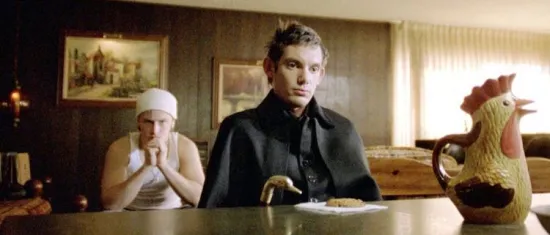
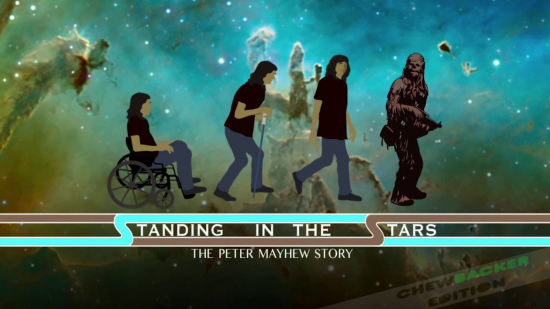
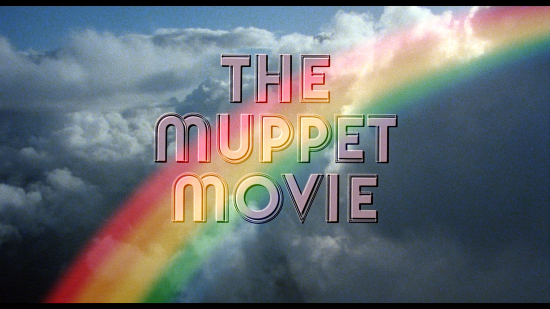
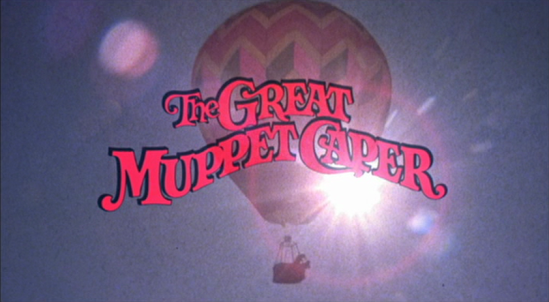


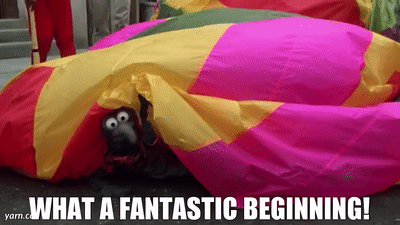





 RSS feed
RSS feed